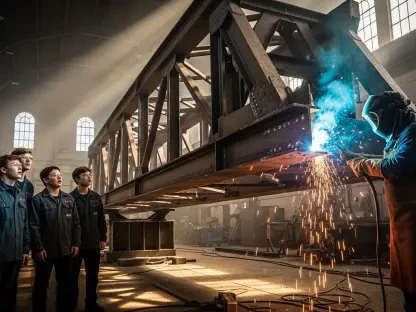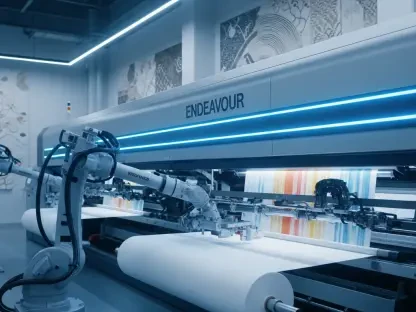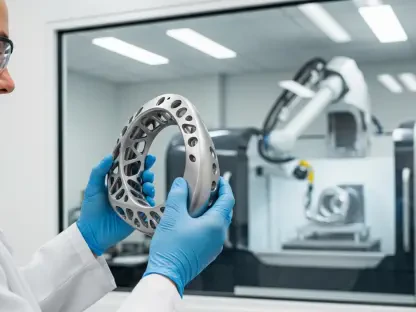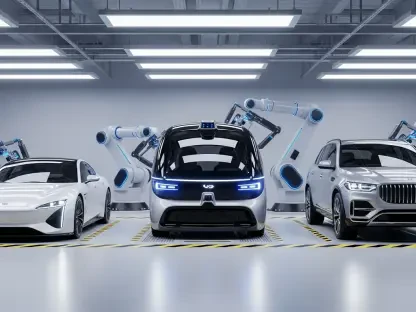The integration of smart automation technologies is redefining industries such as manufacturing and life sciences, signaling a transformative era. According to Deloitte’s recent survey, 92% of manufacturers consider smart-manufacturing technology the cornerstone of their competitive strategy and expect this trend to fully manifest within an imminent timeframe. This sweeping change represents a tangible embodiment of “Industrie 4.0,” a revolution once promised, now being realized through advanced software and sensing technologies that are reshaping workflows profoundly. However, this technological shift is beset by challenges, chiefly the acute shortage of skilled labor to manage these intelligent systems. As the workforce struggles to adapt, firms find themselves grappling with this new landscape, where the demand for tech-savvy professionals far outstrips available supply. Insights from the life sciences sector further echo this scenario, where a majority of R&D executives are investing heavily in AI workflows, indicative of automation’s crucial role. Clearly, smart automation is not merely a luxury but a necessity in meeting rising demands and optimizing operations.
Emergence of Automation in Manufacturing
Smart manufacturing, initially a buzzword, has now ingrained itself as an essential component of operations. The concept of intelligent systems like predictive maintenance, which leverages data to forecast equipment needs, exemplifies this evolution and underpins the broader move towards automation. With the persistence of manual methods, the full potential of real-time data-driven solutions remains untapped, yet many manufacturers hesitate to rely entirely on these technologies due to their perceived immature status. The pressing need for adopting automation reflects in the Deloitte survey’s revelation that nearly half of manufacturers struggle to fill crucial roles for production management. This labor deficit underscores a broader industry challenge and accentuates the urgency in implementing smarter systems that transcend traditional methods. Rather than bolstering payrolls with more personnel, the focus must decisively shift to embedding these systems within operations for enhanced productivity. This radical transformation invites firms to reconsider their approach and invest in technologies capable of driving efficiency beyond mere expansion of their workforce.
Technological Challenges and Collaboration
Navigating the manifold challenges posed by automation necessitates a change in strategy and mindset within companies. One significant obstacle lies in the perception that technology deployment requires profound technical expertise. Dispelling this myth, Ivan Madera points out that effective AI deployment relies more on individuals who understand business processes than those proficient in coding. By leveraging such partnerships between business and technology teams, companies can effectively tailor AI solutions to address real-world issues. This collaboration harmonizes domain expertise and technological prowess, allowing a seamless integration of AI into daily operations. Subject matter experts become crucial, playing a pivotal role in guiding the development and application of AI, ensuring its efficacy in addressing particular needs while complementing human skills. As AI tools mature, they will not only aid in streamlining processes but also redefine roles, creating new opportunities for personnel across various fields. This change signifies a paradigm shift where human workers and technology coalesce, fostering an environment ripe for innovation and efficiency.
Prospects and Workforce Dynamics
Looking to the future, automation projects a shift in focus from tools to intelligent systems acting as co-pilots alongside human teams. This development sees AI not as mere assistants but as partners in engineering design, offering enriched insights grounded in historical data. Consequently, even entry-level engineers find themselves empowered, equipped with Ph.D.-level competencies through enhanced datasets. As industry leaders invest handsomely in automation solutions, contemplating AI as co-pilots underscores their commitment to harnessing technology for a smarter workflow. The notion of “humanoids,” or agentic AI, opens up a vista where these systems proactively navigate operational inefficiencies, recognizing required processes and anticipating needs to refine workflows. This innovative drive promises an operational landscape characterized by dynamic capabilities—an era where tasks adapt swiftly to available resources, ensuring seamless continuity in operations and more flexible production schedules. While automation presents alluring prospects for continuous optimization, achieving round-the-clock systems hinges on overcoming workforce constraints.
Workforce Solutions in Automation
AI’s role in alleviating the workforce shortage cannot be overstated; it transforms how industries operate, especially with companies aiming for perpetual production. Workforce issues pose an undeniable hurdle in realizing fully automated facilities; however, smart systems promise a solution by recalibrating labor availability and streamlining functions. Bridging this gap requires automation systems built to operate seamlessly under varied conditions, catering to available resources and optimizing processes accordingly. Skilled shortages compel manufacturers to embrace automation, not just out of necessity but as a strategic advantage. This transformation fosters an operational environment marked by adaptability, ready to navigate challenges posed by fluctuating workforce availability. By precisely aligning technological capabilities with human skills, organizations can cultivate an agile, resilient ecosystem poised for success. The convergence of automation technology and labor dynamics heralds a new chapter in industry evolution, where adaptability becomes synonymous with advancement and growth.
Strategic Transition in Industry Practices
The strategic transition towards automation signifies a new approach that stands to revolutionize manufacturing and life sciences sectors. Organizations are increasingly recognizing the imperative to embrace smart systems capable of driving efficiency and unlocking new growth avenues. By transcending traditional operational models, they stand to achieve extensive process optimization, enhancing the overall productivity and output. Automation thus emerges as an indispensable strategic lever that enables businesses to mitigate labor shortages while ensuring readiness for unexpected disruptions. The intricacies of implementing real-time data systems underscore a substantive departure from traditional rule-based frameworks, preparing firms for the demands of modern operations. As industries evolve, the integration of intelligent systems is primed to facilitate this journey towards high efficacy, nudging them towards an innovative future. Enterprises adept at navigating this wave of technological advancement will epitomize the strategic transition, having embedded advanced systems seamlessly into their processes, thereby carving out a distinct competitive edge in the global marketplace.
Crafting Competitive Edge and Future Directions
The integration of smart automation technologies is reshaping sectors like manufacturing and life sciences, ushering in a new era of transformation. Deloitte recently reported that 92% of manufacturers now view smart manufacturing technology as key to their competitive edge and anticipate its full impact in the near future. This massive change embodies the long-awaited “Industrie 4.0” revolution, realized through cutting-edge software and sensing technologies that are reshaping processes. However, challenges persist, notably the shortage of skilled workers to operate these advanced systems. As the workforce struggles to catch up, companies contend with this evolving landscape, where the demand for tech-savvy professionals is greater than the supply. In the life sciences field, this trend is mirrored, with most R&D executives investing heavily in AI workflows, underscoring automation’s vital role. Evidently, smart automation is not just an option; it’s essential for meeting growing demands and improving efficiencies.









